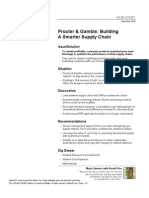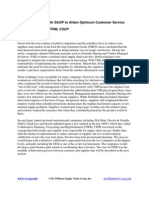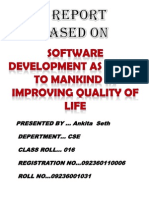0 ratings0% found this document useful (0 votes)
75 viewsCase Study - Channel Partnership Between Walmart and P&G: Made By: Group 4
Case Study - Channel Partnership Between Walmart and P&G: Made By: Group 4
Uploaded by
Arpit GuptaP&G and Walmart improved their partnership by sharing extensive data and moving from a manufacturer-driven sales approach to one focused on consumers. This allowed them to better forecast demand, reduce unnecessary inventory, and increase sales from $375 million to $4 billion by optimizing the supply chain through shared information and new applications. Data sharing built trust between the companies and benefited both as well as the overall industry.
Copyright:
© All Rights Reserved
Available Formats
Download as PPTX, PDF, TXT or read online from Scribd
Case Study - Channel Partnership Between Walmart and P&G: Made By: Group 4
Case Study - Channel Partnership Between Walmart and P&G: Made By: Group 4
Uploaded by
Arpit Gupta0 ratings0% found this document useful (0 votes)
75 views12 pagesP&G and Walmart improved their partnership by sharing extensive data and moving from a manufacturer-driven sales approach to one focused on consumers. This allowed them to better forecast demand, reduce unnecessary inventory, and increase sales from $375 million to $4 billion by optimizing the supply chain through shared information and new applications. Data sharing built trust between the companies and benefited both as well as the overall industry.
Original Description:
case study of P&G
Original Title
4_CaseP&G
Copyright
© © All Rights Reserved
Available Formats
PPTX, PDF, TXT or read online from Scribd
Share this document
Did you find this document useful?
Is this content inappropriate?
P&G and Walmart improved their partnership by sharing extensive data and moving from a manufacturer-driven sales approach to one focused on consumers. This allowed them to better forecast demand, reduce unnecessary inventory, and increase sales from $375 million to $4 billion by optimizing the supply chain through shared information and new applications. Data sharing built trust between the companies and benefited both as well as the overall industry.
Copyright:
© All Rights Reserved
Available Formats
Download as PPTX, PDF, TXT or read online from Scribd
Download as pptx, pdf, or txt
0 ratings0% found this document useful (0 votes)
75 views12 pagesCase Study - Channel Partnership Between Walmart and P&G: Made By: Group 4
Case Study - Channel Partnership Between Walmart and P&G: Made By: Group 4
Uploaded by
Arpit GuptaP&G and Walmart improved their partnership by sharing extensive data and moving from a manufacturer-driven sales approach to one focused on consumers. This allowed them to better forecast demand, reduce unnecessary inventory, and increase sales from $375 million to $4 billion by optimizing the supply chain through shared information and new applications. Data sharing built trust between the companies and benefited both as well as the overall industry.
Copyright:
© All Rights Reserved
Available Formats
Download as PPTX, PDF, TXT or read online from Scribd
Download as pptx, pdf, or txt
You are on page 1of 12
Case Study Channel partnership
between Walmart and P&G
Made By:
Group 4
Key issues
&
Learnings
Sales Driven business approach
1. P&G was a highly diversified company with 12 product divisions but with a very
Fragmented sales approach.
2. In 80s , P&G was obsessed with pushing its sales numbers higher without any
consideration for what the consumers are actually demanding.
3. Each product division had their own sales targets and they separately pushed for
the same without taking the responsibility for the company as a whole.
4. A remedy to rectify such personally driven sales approaches could be conceived by
doing away with the incentivisation of individual sales managers work and instead
focus on sales strategy that is in harmony with the overall brand.
5. The main factor which led to a positive change in the relationship was
communication.
6. A paradigm shift in the sales approach of P&G Walmart was achieved with the use
of extensive data sharing and proper research . The approach shifted to a bottom to
top approach where the final consumers were treated as the King.
Sales Driven Business Approach
7. It was highly important that products now built were consumer centric rather than
manufacturer driven or sales driven.
8. Information technology has played a significant role in achieving to create a
platform where both the business giants effectively shared their data which led to
synergy of operations.
9. It was important that before sharing such crucial information , the businesses had
complete trust in each other and were sure to go forward for the benefit of the
industry as a whole and not solely themselves.
10. The importance of conducting operations honestly can be understood by the fact
that any such critical information once shared can expose the company to multiple
forms of exploitation. For instance :- to increase their bargaining power against each
other, they could use such information. Also , potential sharing of the data with other
industry competitors.
Non-cordial relations between
Walmart and P&G
P&G organizations were too complicated and inflexible.
P&Gs quantitative approach created a point of friction
between the two companies
The lack of use of IT resulted in lesser exchange of data.
P&Gs non-popular products occupied unnecessary shelf
space on Walmart.
The relationship was obsessed with short-term
transactions ignoring long-term transactions
If P&G had thought of Walmart as an extension of its own,
rather than an independent company the relationship
would have been more successful.
Data Delivery Highway Optimization
Data delivery highway
Shelf space requirements were reduced
Insights about customer choices by P&G
Customer requirements identified by Walmart
The degree to which intermediary parties were involved was
reduced- increased savings, improved relations.
A better data flow resulted in better forecast for product
requirement.
Non-cordial relations between
Walmart and P&G
Electronic Data Interchange
Facilitates an automated process of
purchase orders
Invoices
advanced shipment notification
financial payment
Pricing areas were corrected through customer table checking tool.
P&Gs purchase order invoice-match rate went from 15% to 95%.
Non-cordial relations between
Walmart and P&G
Infrastructure development in IT
P&G felt the need to track the sales by customers in the 12
product divisions
P&G had data from the suppliers side ignoring the value of a
single customer and other retailing details like volumes and
margins
Wal-Mart being a retailer, had no link with the supply chain of
P&G
A consolidated data bank is created where both front end and
back information was shared
Rigidity gave way for flexibility after the information sharing
Various optimised support applications like Joint Business
Scorecard, Replenishment, EDI came into the picture for
smooth flow of information
P&G and Wal-Mart aligned the values using this applications
which allowed them to work together towards end consumer
using the combined data
The main point here was the consumer was also benefitting
because of the lowered costs due to the optimized supply
chain information sharing
Infrastructure development in IT
Even after developing some new applications it was found
that some billing systems were not coherent from both sides
So continues development was done in creating new tools to
smoothen the problematic operations, in this case, Customer
Table Checking Tool was built
Another application which made the process efficient was CRP
Continuous Replenishment Process which helps the
Manufacturer to reduce the inventory and do the shipments
in time
In our case, P&G reduced the cycle time by 3 to 4 days
Which enabled Wal-Mart to reach higher financial goals
Infrastructure development in IT
Benefits of Collaboration
1. Reduced Average Inventory
With the sales at Walmart getting executed in less than 24 hours of the product
delivery to their shelf, the average inventory maintained by Walmart as well as
P&G was reduced. This helped to optimize the use of cash in hand with the
groups.
2. Increased Sales/Revenue
Due to synergy benefits between the two groups, there was an increased sales of
32.5% to the final customers.
3. Industrial Growth
Due to the unique mutual partnership approach followed by P&G Walmart, it not
only helped them individually but also led to the growth of the industry . A
example of it can be clearly seen from the increase in sales from $375Mn to a $4
Billion .
SIMILAR CASE IN INDIAN CONTEXT
In the Indian context, companies like Maruti Udyog Ltd have taken full advantage
of such data exchange and information sharing systems technology.
Maruti Udyog in the 1980s and 1990s introduced the concept of Vendor Managed
Inventory (VMI).
Under such an arrangement, Maruti asked its principal vendors to manage the
inventories within its plants.
The vendors representative is allowed to access not only the sales data, but is also
informed of seasonal demand characteristics, upcoming marketing and advertising
activity, and any other information which may affect the sales of Maruti.
The vendor, with this data, could manage the inventory in a leaner and a better
manner. The inventory carrying costs as well as ordering costs reduced
significantly.
This resulted in a mutually beneficial relationship. The vendor could reduce
inventories and this profit was passed on to Maruti, thus resulting in significant
cost reduction and a shift from a push based system to a pull based system.
You might also like
- Supply Chain Management Mba Project DownloadDocument7 pagesSupply Chain Management Mba Project DownloadAhamed Ibrahim100% (3)
- Whitepaper PIM Business CaseDocument13 pagesWhitepaper PIM Business CaseraghuraobiNo ratings yet
- Assignment 1 - Question 1Document2 pagesAssignment 1 - Question 1Amit BiswalNo ratings yet
- Retailer Supplier PartnershipsDocument18 pagesRetailer Supplier Partnershipscharurastogi83% (18)
- ITM CaseDocument10 pagesITM CasePramod JuyalNo ratings yet
- BPSK SimulinkDocument13 pagesBPSK SimulinkpootommyNo ratings yet
- Article Review On Supply Chain of WalmartDocument7 pagesArticle Review On Supply Chain of WalmartNaina AgarwalNo ratings yet
- CRP Walmart & Procter and GambelDocument8 pagesCRP Walmart & Procter and Gambelمعتز العطارNo ratings yet
- P&GDocument7 pagesP&GAli Jibran100% (1)
- Supply-Chain Integration Through Information Sharing: Channel Partnership Between Wal-Mart and Procter & GambleDocument2 pagesSupply-Chain Integration Through Information Sharing: Channel Partnership Between Wal-Mart and Procter & GambleMohsin AliNo ratings yet
- Fulfilling The Promise of CPFR in CPG and Retail: CPFR: A Brief HistoryDocument5 pagesFulfilling The Promise of CPFR in CPG and Retail: CPFR: A Brief HistoryDwight HerlongNo ratings yet
- HW - Chapter 4Document7 pagesHW - Chapter 4Yến NhưNo ratings yet
- Market Guide For Retail Dist 352250Document36 pagesMarket Guide For Retail Dist 352250AndersonVieiraNo ratings yet
- Data Warehousing (2002-05 IBM Ex)Document40 pagesData Warehousing (2002-05 IBM Ex)Abou Bahaj100% (1)
- Combining CPFR With S&OPDocument9 pagesCombining CPFR With S&OPMark K. Williams100% (2)
- MR - A - G2 - GAP CaseDocument13 pagesMR - A - G2 - GAP Caseshaurya shantamNo ratings yet
- Chase SAS - Market-Driven Demand ManagementDocument5 pagesChase SAS - Market-Driven Demand ManagementStevoIlicNo ratings yet
- What Other Supply Chain Opportunities Should West Marine Pursue As The Company Looks Forward?Document3 pagesWhat Other Supply Chain Opportunities Should West Marine Pursue As The Company Looks Forward?Gaurav MadanpuriNo ratings yet
- 01 - Overview and ConceptsDocument44 pages01 - Overview and Conceptsandreimcpe123No ratings yet
- Bringing Science To The Art of Revenue SynergiesDocument6 pagesBringing Science To The Art of Revenue SynergiesGlori ortuNo ratings yet
- Dairy Farm GroupDocument6 pagesDairy Farm GroupAkash MishraNo ratings yet
- Channel Partnership Between WM & PGDocument22 pagesChannel Partnership Between WM & PGLong NguyễnNo ratings yet
- Barilla Spa A - Team-1 (EMBA-07)Document4 pagesBarilla Spa A - Team-1 (EMBA-07)Dola GholaNo ratings yet
- INS511: Perspective On Market Research Sector Section I Assignment I: State of Market Research IndustryDocument6 pagesINS511: Perspective On Market Research Sector Section I Assignment I: State of Market Research IndustryJanki SolankiNo ratings yet
- SCPM Assignment 1Document11 pagesSCPM Assignment 1AnandhNo ratings yet
- A Simpler Way To Modernize Your Supply ChainDocument23 pagesA Simpler Way To Modernize Your Supply ChainragerahulNo ratings yet
- Chapter 1 Introduction To Supply ChainsDocument3 pagesChapter 1 Introduction To Supply ChainsAnup DasNo ratings yet
- Executive Summary Gartner Group & Research Marketing Databases Data Warehousing Data Management ConclusionDocument10 pagesExecutive Summary Gartner Group & Research Marketing Databases Data Warehousing Data Management ConclusionRejan KarmacharyaNo ratings yet
- 08 - IT and Corporate StrategyDocument11 pages08 - IT and Corporate StrategyKamran MirzaNo ratings yet
- 2A VMI Kellogg ReportDocument12 pages2A VMI Kellogg ReportPrafull MalviyaNo ratings yet
- Walmart PG The Emergence of Supply Chain ExcellenceDocument19 pagesWalmart PG The Emergence of Supply Chain ExcellenceRoshanNo ratings yet
- P&GDocument3 pagesP&GSteffiNo ratings yet
- Vendor Managed Inventory (Vmi)Document10 pagesVendor Managed Inventory (Vmi)France ParodiNo ratings yet
- BI For Retail 0526Document8 pagesBI For Retail 0526Bhargav KopparapuNo ratings yet
- How To Get Product Data Right and Gain A Competitive Edge - Consumer Goods TechnologyDocument12 pagesHow To Get Product Data Right and Gain A Competitive Edge - Consumer Goods TechnologyVernon BewleyNo ratings yet
- Contribution of Information Systems To Pursue Competitive StrategiesDocument16 pagesContribution of Information Systems To Pursue Competitive StrategiesSuyog PowarNo ratings yet
- Logistic 2Document9 pagesLogistic 2ahmed amiraliNo ratings yet
- By H. Jefferson Smith: Do Data Warehouses Challenge Fair Play?Document2 pagesBy H. Jefferson Smith: Do Data Warehouses Challenge Fair Play?Jagadeesh Padaki100% (1)
- ForecastingDocument7 pagesForecastingDapoer OmaOpaNo ratings yet
- 02 Midterm MIS001 Lecture 2.2Document18 pages02 Midterm MIS001 Lecture 2.2Athena DeniseNo ratings yet
- Unit 5Document4 pagesUnit 5Bhaskaran BalamuraliNo ratings yet
- Retail TechDocument21 pagesRetail TechmadhavNo ratings yet
- CRM - Final Exam NotesDocument9 pagesCRM - Final Exam NotesAdithia Putra PratamaNo ratings yet
- 10 Strategies For The Retail CIODocument7 pages10 Strategies For The Retail CIOkarthiknaga1989No ratings yet
- Pim For Retail IndustryDocument13 pagesPim For Retail IndustryraghuraobiNo ratings yet
- Supply Chain Management and The Catalytic Role of The Management AccountantDocument7 pagesSupply Chain Management and The Catalytic Role of The Management Accountantvb_krishnaNo ratings yet
- ch3. Achieving Competitive Advantage With Information SystemsDocument23 pagesch3. Achieving Competitive Advantage With Information Systemssami benamerNo ratings yet
- Value Chain Analysis of Procter and Gamble Case StudyDocument5 pagesValue Chain Analysis of Procter and Gamble Case StudyNgoc Ngo BichNo ratings yet
- Retail Book Chap10Document23 pagesRetail Book Chap10Harman Gill100% (2)
- 5 TH Module of Supply Chain ManagementDocument18 pages5 TH Module of Supply Chain ManagementSunil ChauhanNo ratings yet
- Staples - "Removing The Seams in The Supply Chain": Company Profile and Business ContextDocument8 pagesStaples - "Removing The Seams in The Supply Chain": Company Profile and Business ContextSwapan Kumar SahaNo ratings yet
- The Seven Principles of Supply Chain ManagementDocument15 pagesThe Seven Principles of Supply Chain Managementsnandhni510No ratings yet
- E-Com Module 2Document15 pagesE-Com Module 2ritikagraphicdesigner5No ratings yet
- Big Data Use CasesDocument13 pagesBig Data Use CaseshabibNo ratings yet
- A Study On Affiliate Marketing With Special Reference To: by Karthi .RDocument14 pagesA Study On Affiliate Marketing With Special Reference To: by Karthi .RKarthi BadManNo ratings yet
- Supply Chain Management The Supply Chain E-Marketplaces Why The Internet? 1 3 5 7Document13 pagesSupply Chain Management The Supply Chain E-Marketplaces Why The Internet? 1 3 5 7spiro40No ratings yet
- Unit2Document23 pagesUnit2rahulparoche251No ratings yet
- AMR Research ARTICLE 15682-The New CPG and Life Sciences Business PDocument2 pagesAMR Research ARTICLE 15682-The New CPG and Life Sciences Business PRajesh RayNo ratings yet
- Unit - 3 - The Strategic Role of Information SystemDocument24 pagesUnit - 3 - The Strategic Role of Information SystemPrijesh Rana PndNo ratings yet
- Lewis Model Analysis of ChinaDocument14 pagesLewis Model Analysis of ChinaArpit Gupta100% (1)
- BRM - Group 9Document9 pagesBRM - Group 9Arpit GuptaNo ratings yet
- Planning Organizing Staffing Directing Communicate Co-Ordinate Reporting Budgeting Attracting - HRP & Rec Retaining Comp. AdmnDocument59 pagesPlanning Organizing Staffing Directing Communicate Co-Ordinate Reporting Budgeting Attracting - HRP & Rec Retaining Comp. AdmnArpit GuptaNo ratings yet
- Women in WorkDocument1 pageWomen in WorkArpit GuptaNo ratings yet
- MumbaiDocument17 pagesMumbaiArpit GuptaNo ratings yet
- Aravind Eye Care SystemDocument5 pagesAravind Eye Care SystemArpit GuptaNo ratings yet
- APEDADocument8 pagesAPEDAArpit GuptaNo ratings yet
- Company of India LimitedDocument2 pagesCompany of India LimitedArpit GuptaNo ratings yet
- Lempel ZivDocument7 pagesLempel ZivDũng Nguyễn TrungNo ratings yet
- Supply Chain Integration Through Information SharingDocument21 pagesSupply Chain Integration Through Information SharingAwetahgn TsegayNo ratings yet
- Electrical TechDocument709 pagesElectrical TechArpit GuptaNo ratings yet
- The Rsmemory ReportDocument3 pagesThe Rsmemory ReportNikki GonzalesNo ratings yet
- Product Information Test Blocks: Indentec Hardness TestingDocument1 pageProduct Information Test Blocks: Indentec Hardness TestingVishal KarmakarNo ratings yet
- Port TriggeringDocument4 pagesPort TriggeringkaltstefNo ratings yet
- CachingDocument7 pagesCachingnikkusonikNo ratings yet
- Digital Transformation With Trimble Constructible Process: Ketty NarulitaDocument15 pagesDigital Transformation With Trimble Constructible Process: Ketty NarulitaKamal FitriNo ratings yet
- Java Day1Document78 pagesJava Day1Hemanth Kumar Reddy YedulaNo ratings yet
- Captcha' in Web SecurityDocument36 pagesCaptcha' in Web SecurityAbhishek SharmaNo ratings yet
- Iscrm: Solution For Customer Relationship Management SystemDocument12 pagesIscrm: Solution For Customer Relationship Management Systemminhdung.pham4713No ratings yet
- GMS - Getting StartedDocument67 pagesGMS - Getting Startedsergioodin48510% (1)
- Ieee Vision For Smart Grid Controls: 2030 and BeyondDocument10 pagesIeee Vision For Smart Grid Controls: 2030 and BeyondHgoglezNo ratings yet
- Basics of SFMS StandardsDocument3 pagesBasics of SFMS Standardsgani_scribd0% (1)
- DNG 7.2 Converter ReadMeDocument14 pagesDNG 7.2 Converter ReadMemizor_99No ratings yet
- V2801S - 1GE Dual Mode ONU ManualDocument8 pagesV2801S - 1GE Dual Mode ONU ManualMorrison Javier QuispeNo ratings yet
- Python NotesDocument2,129 pagesPython NotesJallal ShaikNo ratings yet
- What Is Tableau DesktopDocument3 pagesWhat Is Tableau DesktopvikramrajuNo ratings yet
- TransactionDocument25 pagesTransactionlgollapaNo ratings yet
- Escape: Programming Language: HTML, CSS Report Writing: WordDocument1 pageEscape: Programming Language: HTML, CSS Report Writing: WordPoojaNo ratings yet
- Hydrodynamic Simulation of Unsteady Dam Break FlowsDocument17 pagesHydrodynamic Simulation of Unsteady Dam Break Flowsvinayhit1100% (1)
- 2.markov ChaainsDocument17 pages2.markov ChaainssandyNo ratings yet
- PRESENTED BY Ankita Seth Depertment Cse Class Roll 016 REGISTRATION NO 092360110006 ROLL NO 09236001031Document19 pagesPRESENTED BY Ankita Seth Depertment Cse Class Roll 016 REGISTRATION NO 092360110006 ROLL NO 09236001031Ankita SethNo ratings yet
- 749 Assignment 2Document12 pages749 Assignment 2Sumit PaulNo ratings yet
- The Best HR KPIs Aligned With Company StrategyDocument6 pagesThe Best HR KPIs Aligned With Company StrategyLOBOCRISPNo ratings yet
- Creating Classes, Objects, and MethodsDocument10 pagesCreating Classes, Objects, and MethodsKiky Firadella NellyNo ratings yet
- V80M MotherboardDocument94 pagesV80M MotherboardZeColtzNo ratings yet
- What Are Uncertainty BudgetsDocument18 pagesWhat Are Uncertainty BudgetsRangga K NegaraNo ratings yet
- RefMan Forms Spring2017 V2Document120 pagesRefMan Forms Spring2017 V2PatrickNo ratings yet
- SDLC On Cloud ComputingDocument9 pagesSDLC On Cloud ComputingRajat Panda100% (1)
- HTML Parser PHP TutorialDocument13 pagesHTML Parser PHP Tutorialzeroxcool4968No ratings yet
- UCINET Visualization and Quantitative Analysis TutorialDocument53 pagesUCINET Visualization and Quantitative Analysis TutorialGerardo DamianNo ratings yet




































































































